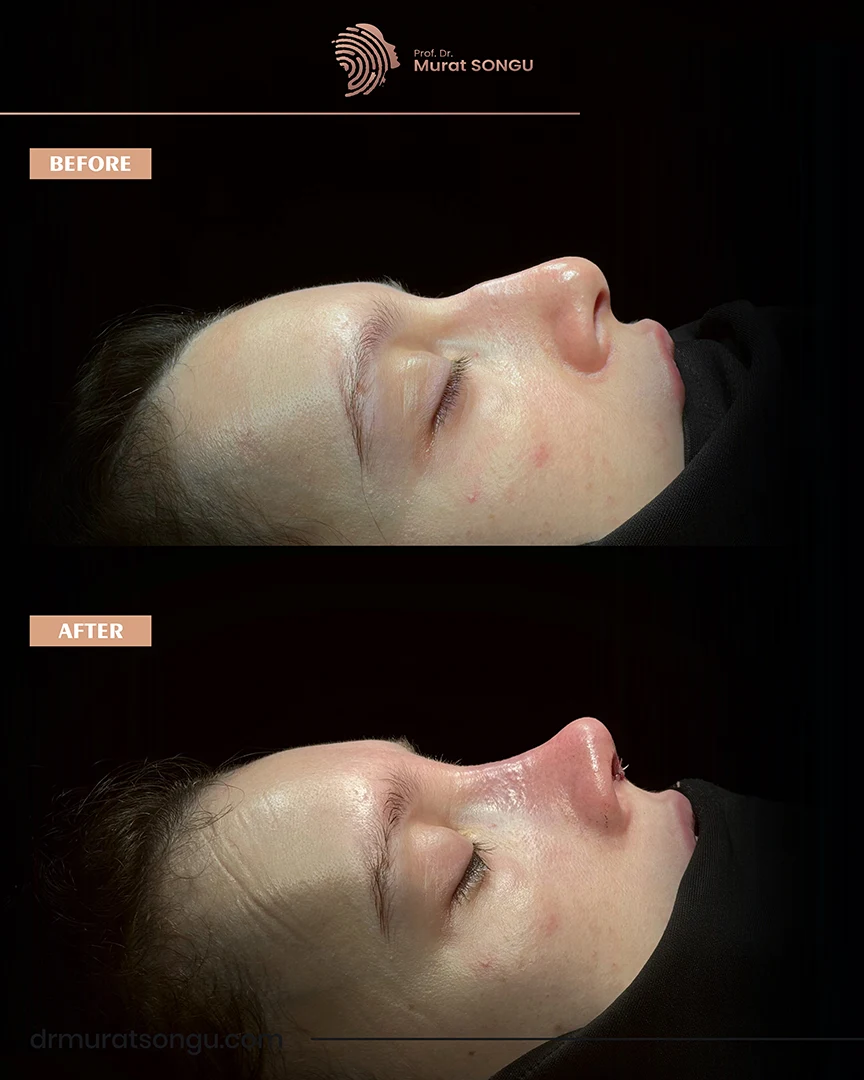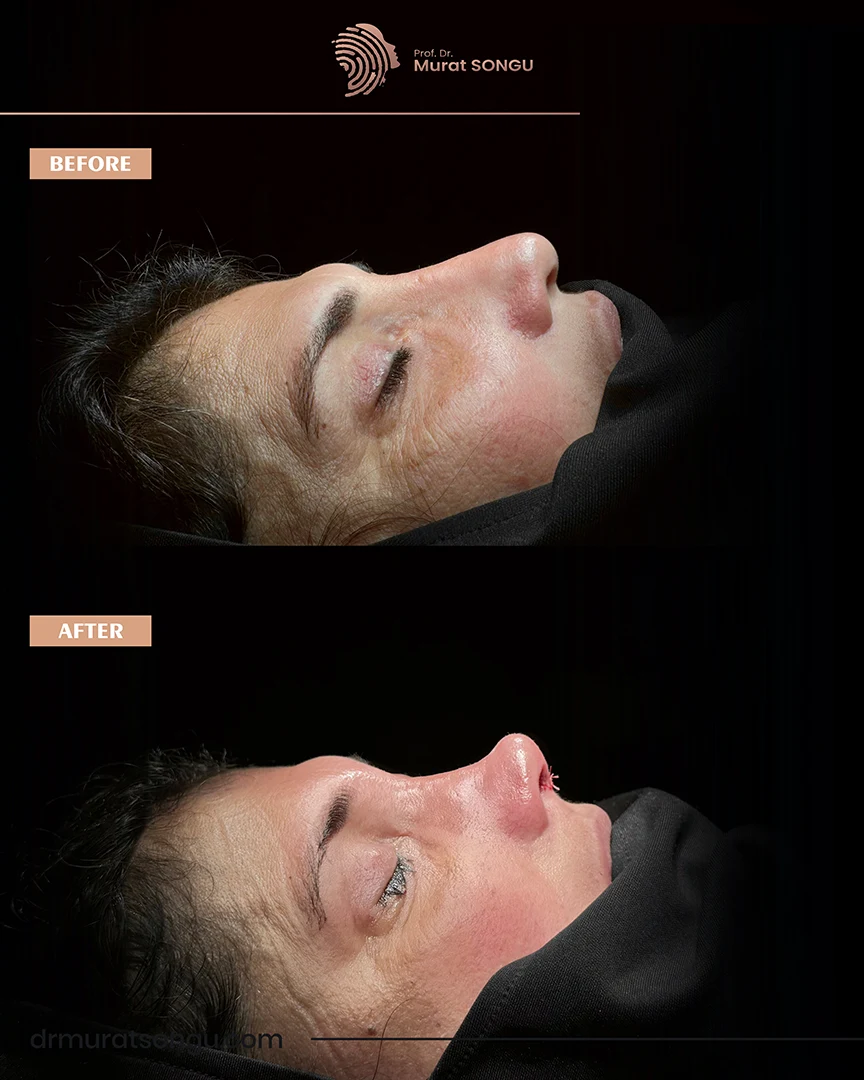Tip Rhinoplasty, also known as nose tip rhinoplasty, is a surgical procedure aimed at modifying the nasal tip to enhance its shape and appearance. This procedure can be performed in Turkey, where skilled surgeons employ advanced techniques to achieve optimal results. With a focus on precision and aesthetics, tip rhinoplasty in Turkey offers individuals the opportunity to refine their nasal tip through various surgical approaches.
Whether through closed or open techniques, surgeons employ meticulous incisions and manipulation of the cartilage to achieve desired changes in projection, rotation, and overall nasal harmony. By undergoing tip rhinoplasty in Turkey, patients can benefit from the expertise of experienced surgeons and the country’s reputation for medical excellence.
Table of Content
One of the Best Surgeons for Tip Rhinoplasty in Turkey

Prof. Dr. Murat Songu is recognized as one of the top surgeons for tip rhinoplasty in Turkey, offering meticulous nasal tip refinement that maintains function while enhancing definition. His delicate technique ensures subtle, symmetrical improvements suited to each individual’s facial structure.
What Is Tip Rhinoplasty?
Tip Rhinoplasty, also known as nasal tip rhinoplasty, is a surgical procedure that focuses on modifying and refining the appearance of the nasal tip. It is a specialized technique within the field of rhinoplasty, specifically targeting the tip area to achieve desired aesthetic changes. During tip rhinoplasty, the surgeon carefully reshapes the cartilage and underlying structures of the nasal tip to enhance its projection, rotation, and overall symmetry.
This procedure can address concerns such as bulbous or drooping nasal tips, asymmetry, or lack of definition. With the expertise of skilled surgeons, tip rhinoplasty aims to create a balanced and harmonious nasal tip that complements the overall facial features, resulting in improved facial aesthetics and self-confidence.
How Is Tip Rhinoplasty Performed?

During a tip rhinoplasty procedure, the surgeon employs various surgical techniques to modify the nasal tip. The specific approach used depends on the individual’s unique needs and desired outcome. The procedure can be performed using either a closed (endonasal) or open (external) approach.
In a closed approach, the surgeon makes incisions within the nostrils to access the nasal tip, while an open approach involves additional incisions that allow for greater visibility and manipulation. Through meticulous incisions and cartilage manipulation, the surgeon can alter the projection, rotation, and overall shape of the nasal tip. The goal is to achieve a harmonious and aesthetically pleasing nasal appearance that complements the patient’s facial features.
Recovery Process After Tip Rhinoplasty
The recovery process following tip rhinoplasty involves several important considerations. After the surgery, patients can expect some swelling and bruising around the nasal tip, which is a normal part of the healing process. The use of prescribed medications can effectively alleviate pain and discomfort. Nasal packing may be used temporarily to support the nasal structures and control bleeding.
Patients are advised to keep their head elevated and avoid strenuous activities for a few weeks to minimize swelling and promote healing. It is important to follow the post-operative instructions provided by the surgeon, which may include wearing a splint or bandage on the nose and using saline sprays or rinses for nasal hygiene. Patients should attend follow-up appointments to monitor their progress and address any concerns. Recovery times may vary, but most individuals can expect to see gradual improvements in the appearance of their nasal tip over several weeks or months.
What Affect the Cost of Tip Rhinoplasty?
Different factors will be factored in when determining the cost of tip rhinoplasty. The first among them would be the level of skill by the surgeon. A very experienced surgeon who has done many successful surgeries is likely to charge very high fees. Besides, complexity of the surgical process has an important repercussion on the cost. The price for the refinement of the tip is cheaper than that for reshaping the tip or those that need additional cartilage grafts added.
Second is where the clinic is located, and this will geographically influence the cost. In most cases, places living with a high cost normally portray high charges for surgeries like tip rhinoplasty. Furthermore, added costs come from the use of medical facilities and anesthesia.
- Surgeon’s expertise influences fees.
- The price is affected by the complexity.
- The Geographic Location Affects Costs.
Plus, anesthesia and facility fees would be added. All these factors together add up to the overall cost of going in for a tip rhinoplasty.
Before & After Photos















































Is It Safe To Have Tip Rhinoplasty In Turkey?
Having a tip rhinoplasty in Turkey is generally considered safe due to the country’s well-established medical infrastructure and reputable healthcare providers. Turkey is renowned for its experienced and skilled surgeons who undergo rigorous training and adhere to high standards of patient care. The medical facilities in Turkey are equipped with state-of-the-art technology, ensuring safe and successful surgical procedures.
Additionally, many clinics and hospitals in Turkey maintain international accreditation and follow strict protocols for hygiene and sterilization. Before undergoing tip rhinoplasty, it is crucial to research and choose a reputable surgeon and facility, ensuring they are board-certified and have a proven track record of delivering excellent results. As with any surgical procedure, thorough preoperative assessments, clear communication with the surgeon, and adherence to postoperative care instructions are essential for a safe and successful outcome.
Why Is Tip Rhinoplasty Cheap In Turkey?
The affordability of tip rhinoplasty in Turkey can be attributed to several factors. Firstly, Turkey has a lower cost of living compared to many Western countries, resulting in lower overhead expenses for medical facilities and professionals. Additionally, the competition within the Turkish healthcare sector contributes to competitive pricing for cosmetic procedures, including tip rhinoplasty. Turkey is renowned for its highly skilled and experienced surgeons who offer quality healthcare services at more affordable prices.
The availability of state-of-the-art medical facilities and advanced surgical techniques further enhances the cost-effectiveness of tip rhinoplasty in Turkey. Moreover, the country’s robust medical tourism industry attracts international patients, leading to economies of scale and reduced costs. Overall, these factors combine to make tip rhinoplasty a more cost-effective option in Turkey.
Tipplasty Reviews
F.A.Q.
Nose tip aesthetics with fillers is not a permanent solution. The fillers used in this procedure typically last between 8 and 12 months. The duration depends on the patient’s skin type, lifestyle, and adherence to the doctor’s recommendations. Additionally, the type of filler used is also important. When the filler procedure is repeated, the effect of the filler may last longer than the initial application. The effects of this non-surgical procedure can be seen immediately after the procedure. It takes about 10 to 15 days for the filler to fully settle in the skin and take its final shape. Therefore, the permanence of this aesthetic procedure is limited.
Nose tip aesthetics is generally performed when facial development is complete. This process usually covers the ages of 15-16 for girls and 17-18 for boys. However, these ages should not be seen as strict limits. Especially the doctor’s evaluation and special circumstances may require an operation outside of this age range. Additionally, in aesthetic procedures, it is important to wait for the completion of facial development. This ensures healthier results both aesthetically and functionally. Therefore, the ideal age for nose tip aesthetics with fillers can vary based on individual circumstances and the doctor’s advice.
Nose tip aesthetics is a surgical procedure that corrects the shape of the nose tip. It is generally preferred in individuals who do not have problems with the nasal bridge or septum (the middle partition of the nose). It is also ideal for those with nasal tip asymmetry. Furthermore, since it is performed with a minimally invasive approach, the recovery process is quick. It can also address breathing issues by intervening in the septum and turbinates. Thus, both aesthetic and functional improvements are achieved.
Nose tip aesthetics is generally considered safe. However, like any surgical intervention, it carries some risks. There is a risk of infection, although rare. Additionally, asymmetry or undesirable results may occur during the healing process. Swelling and bruising are typically minimal but may be more pronounced in some patients. Difficulty in breathing is another issue that may be encountered after the operation. Finally, sensory changes can be temporary or permanent. Therefore, a detailed evaluation before the operation is important.
During nose tip aesthetics, the treatment of septal deviation and turbinate problems causing nasal congestion can also be performed. First, the surgeon thoroughly examines the nasal structure. Then, a plan is made to combine aesthetic and functional improvements. Thus, the patient’s satisfaction is ensured both aesthetically and health-wise. Although technically challenging, this does not pose a barrier for experienced surgeons. Therefore, patients have the opportunity to achieve both aesthetic and functional improvements.
There is generally no obstacle for individuals with sinusitis to undergo nose tip aesthetics. However, it is important to be careful during this process. First, attention should be paid to the expertise and experience of the surgeon performing the procedure. An expert doctor can evaluate the patient’s overall health during the examination and determine the effects of sinusitis on the aesthetic operation. This way, possible risks after the operation are minimized, and the chance of a successful outcome increases. Therefore, those with sinusitis can also have nose aesthetics.
Some doctors prefer the method of local anesthesia in nose tip aesthetics surgeries, but it is not suitable. One of the main reasons for its unsuitability is that it reduces surgical success. It also decreases the patient’s comfort. Therefore, local anesthesia is not commonly preferred in nose tip aesthetics.
Awards




















